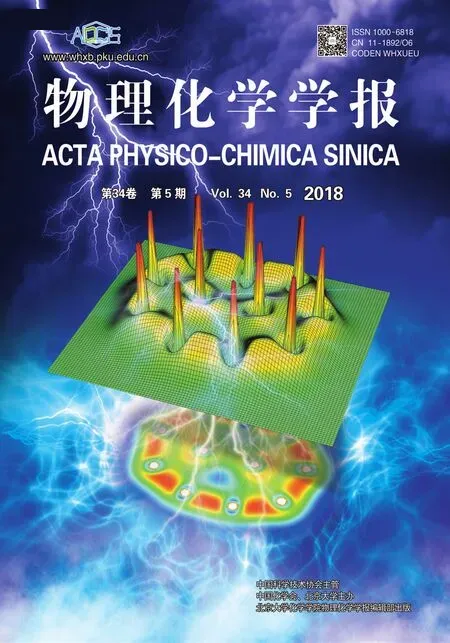Constan t Tem peratu re from Phase Space View of Ensem b les of Excited States
2018-03-07LIUShubin
LIU Shubin
Research Computing Center, University of North Carolina, Chapel Hill, North Carolina 27599-3420, USA.Email: shubin@email.unc.edu
Several decades ago Ghosh, Berkow itz and Parr1rew rote the ground-state density functional theory (DFT) into a local thermodynam ics. They obtained a phase–space distribution function by maxim izing the phase-space Shannon information entropy w ith fixed density and local kinetic energy density (of the DFT). A local Maxwell-Boltzmann distribution function was resulted. They introduced the concept of local temperature.Though, there is only an analogy between the thermodynam ics and the density functional theory of a single atom or molecule,it is still amazing that these systems can be considered as an“ideal gas”. Even the fundamental equations2can be derived and the time-dependent density functional theory can be formalized as a thermodynamics w ith balance equations3for the energy and entropy.
The thermodynam ical transcription has been recently extended to ensembles of excited states a few years ago by Nagy4. In its original formulation density functional theory was a groundstate theory, but later was extended to excites states as well5,6.The author showed that the ensemble theory of excites states can be reformulated as a local thermodynam ics and ensemble local temperature and entropy can be defined.
The Ghosh-Berkow itz-Parr theory has the peculiar property that the local temperature is not uniquely defined, which is troublesome and puzzling. It is the consequence of the ambiguity of the kinetic energy density, which might have a few different forms. In principle, any kinetic energy density that integrates to the same kinetic energy can do. In a recent paper7Nagy proved that it is possible to select the kinetic energy density so that the local temperature be a constant for the whole system under consideration. Moreover, it turned out that, as her proof shows,the kinetic energy density corresponding to the constant temperature also maxim izes the information entropy at the same time.
As a continuation of her previous studies, in the present paper(This paper is published online in the Journal of Acta Physico-Chim ica Sinica, doi: 10.3866/PKU.WHXB201709221)8,Professor Ágnes Nagy (University of Debrecen, Hungary)has extended the idea of constant temperature to ensembles of excited states. The generalization is based on the fact that the ensemble kinetic energy density is not defined uniquely either.The author has proved that the ensemble temperature corresponding to the extremum phase-space information entropy is constant. The ensemble kinetic energy density simultaneously maxim izing the phase-space information entropy is found to be proportional to the ensemble density, while the ensemble temperature is proportional to the ensemble kinetic energy.Interestingly, the Maxwell-Boltzmann distribution function still holds true and the entropy has the form of the Sackur-Tetrode expression of the classical ideal gas8.
References
(1) Ghosh, S. K.; Berkow itz, M.; Parr, R. G. Proc. Natl. Acad. Sci. U. S.A. 1984, 81, 8028.
(2) Nagy, Á.; Parr, R. G. J. Mol. Struct. (Theochem) 2000, 501, 101.doi: 10.1016/S0166-1280(99)00418-2
(3) Nagy, Á. J. Mol. Struct. (Theochem) 2010, 48, 943.doi: 10.1016/j.theochem.2009.10.010
(4) Nagy, Á. Indian J. Chem. A 2014, 53, 965.
(5) Theophilou, A. K. J. Phys. C 1978, 12, 5419.doi: 110.1088/0022-3719/12/24/013
(6) Gross, E.K.U.; Oliveira, L.N.; Kohn, W. Phys. Rev. A 1988, 37, 2805;2809; 2821. doi: 10.1103/PhysRevA.37.2805;10.1103/PhysRevA.37.2809; 10.1103/PhysRevA.37.2821
(7) Nagy, Á. Int. J. Quantum Chem. 2017, 117. doi: 10.1002/qua.25
(8) Nagy, Á. Acta Phys. -Chim. Sin. 2018, 34, 492.doi: 10.3866/PKU.WHXB201709221
杂志排行
物理化学学报的其它文章
- RbCl和CsCl水溶液结构的X射线散射及经验势结构精修模拟
- Adso rp tion of Hyd razoic Acid on Pristine Graphyne Sheet:A Com pu tational Study
- Chem ical Bond ing and In terp retation of Tim e-Dependen t Elec tronic Processes w ith Maxim um Probability Dom ains
- 芘二酰亚胺:兼具高电子迁移率和双光子荧光性能的有机半导体
- Fukui函数和局域软度应用于亲电加成反应的区位选择性的研究
- Generalized Hirsh feld Partitioning w ith Orien ted and Prom o ted Proatom s
